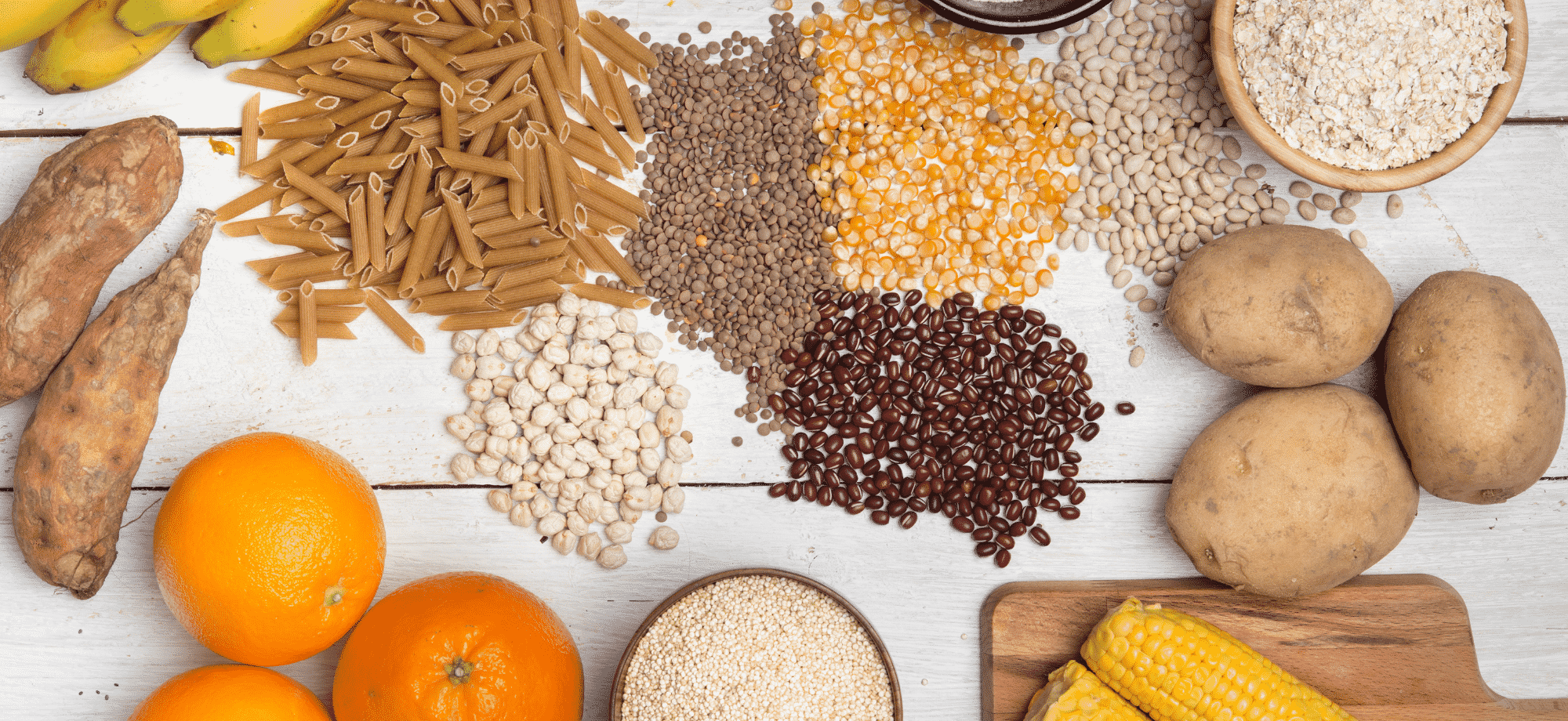The difference between simple and complex carbs is, well, not so simple. Here’s what you need to know about all carbs, plus how to include this important nutrient in your diet for optimal energy and health.
The Basics of Carbohydrates
Carbohydrates are one of the three essential macronutrients, along with fat and protein, that your body needs to function. But not all carb-containing foods are created equal, and how you get them from your diet can impact your health for better or for worse. The types of carbs a person chooses to consume can have a major effect on their metabolic health—that is, how your body breaks down and derives energy from the food you eat. Poor metabolic health can lead to weight gain, heart disease, and Type 2 diabetes. Fortunately, part of your metabolic health is in your control, and it starts with healthy eating. And, yes, healthy eating can (and should!) include carbohydrates.
“There is no question that we need to watch the amounts of added sugar in our diets. But we shouldn’t vilify a whole class of nutrients,” says Catherine Yeckel, Ph.D., a human metabolism and nutrition researcher and an assistant clinical professor at Yale School of Public Health. “Our body needs carbs because tissues like the brain, spinal cord, and most of our cells use glucose as their main fuel source.” In this guide, we’ll explain the basics of carbs — like what makes some of them “simple” and others “complex” — and what you can do to support your metabolic health and give your body the lasting energy it needs.
What is a Carbohydrate?
Carbohydrates are the body’s primary source of energy. Your body breaks down carbohydrates in food into a form of sugar called glucose. Glucose is the main fuel for cells, and it travels in the bloodstream to give energy to all your muscles, organs, and tissues. Carbs make up the largest proportion of calories in a typical diet. They come in three forms — sugar, starch, and fiber — and can be found in many foods, from fruits and vegetables, dairy, rice, beans, breads and cakes, and beverages. There are 4 calories of energy in every gram of carbohydrate, and your body uses that energy immediately or saves it up for the future depending on the type of carb you’re consuming.
How Does the Body Process Carbohydrates?
When you eat foods with carbohydrates, your digestive system breaks them down into glucose, which is delivered into the bloodstream. In response to the increase in blood glucose levels, the pancreas produces and releases a hormone called insulin, which prompts cells to take in the available glucose. Insulin helps convert glucose into energy that can be used right away, which could be to support basic functioning or help you break your personal record in a 5K, or it’s stored as glycogen in your muscles and liver for later use. Excess glucose, i.e., beyond what we can store, will be converted into fat.
As glucose is shuttled into cells, blood sugar levels begin to fall and the pancreas releases glucagon, which tells the liver to release stored glucose. The hormones work together to keep blood sugar levels stable. But a big rush of sugar into the bloodstream will cause a spike in insulin release and a quick burst of energy followed by a severe dip in both, a feeling commonly known as the “crash.” “The brain is sensitive to blood glucose and your feeling of fatigue is strong when your blood glucose is low,” Dr. Yeckel says. Over time, pumping out a lot of insulin to deal with high sugar intake can cause the body to become less responsive to insulin (insulin resistant), which could eventually lead to Type 2 diabetes. “Insulin is one of the greatest storage systems,” says Patrick Davitt, Ph.D., assistant professor of kinesiology and program director of exercise physiology at the University of the Sciences in Philadelphia. “If you’re increasing insulin, your body stops breaking down fat, it tells your body to store fat.” This is why it’s important to understand the difference between simple carbohydrates, which your body processes quickly, and complex carbohydrates, which take longer to break down and help keep blood glucose levels more stable.
What are Simple Carbohydrates?
“Simple carbohydrates are those that are broken down quickly by the body to be used for energy,” says Leslie Bonci, a registered dietitian and owner of Active Eating Advice. Simply put: they’re sugars. That includes not only sugar that’s added to foods like candy, desserts, and soda, but also those which occur naturally in foods, Bonci explains.
Examples of Natural Sugars
- Glucose: Found in honey and molasses
- Fructose: Found in fruits and some vegetables
- Lactose: Found in milk and other dairy products
- Maltose: Found in grains
-
Sucrose: A combination of glucose and fructose, which is found in plants and used to make table sugar
Fructose, galactose, and glucose are monosaccharides, molecules made up of a single sugar. Sucrose is an example of a disaccharide, made up of two sugar molecules: glucose and fructose. (Maltose and lactose are also disaccharides.) They all have simple chemical structures, which makes them very easy to break down. That often raises your blood sugar quickly, which can be more than your body needs or can use at the moment, followed by a big dip a few hours later.
Foods Containing Simple Carbohydrates
- White bread
- White flour
- Pasta
- Crackers
- Cereals
- White rice
- Fruit
- Berries
- Fruit juice
- Milk
- Regular soda
- Cookies
- Cake
- Candy
What are Complex Carbohydrates?
As the name suggests, complex carbohydrates are more complex molecules than simple carbs, and therefore take more time for your body to break down into sugar. “You could eat simple carbs and complex carbs in the same amount at the same time and they’ll behave differently,” says Dr. Davitt. Whereas simple carbs are composed of one or two sugars, complex carbs comprise three or more monosaccharides bonded together (called polysaccharides). Because it takes a while to digest them, complex carbohydrates don’t raise your blood sugar as dramatically. They elevate it slowly and keep it steady longer. Essentially, simple carbohydrates will raise blood glucose quickly and complex carbohydrates take longer to deliver glucose to the blood.
Examples of Complex Carbohydrates
- Starches
- Fibers
- Whole-wheat bread
- Whole-wheat pasta
- Whole grains (such as whole wheat, buckwheat, and quinoa)
- Sweet potatoes
- Lentils
- Beans and other legumes
- Corn
- Nuts
- Oatmeal
- Brown rice
Which are Better — Simple or Complex Carbs?
“The majority of your carb intake should come from complex carbs.” Dr. Davitt says. “If you’re an athlete, that gets tweaked only a little." Not all simple carbs are bad. For instance, fruits and vegetables contain simple carbs, but you wouldn’t want to cut those out of your diet. That’s because fruits and vegetables — along with beans and whole grains — often contain complex carbs too, and they provide your body with important vitamins and other nutrients. Now compare that to a packaged cupcake or sugary sports drink and you get a very different picture: lots of simple carbs that spike your blood sugar without the benefits of healthful nutrition.
“The most obvious reason that we should keep blood sugar steady and controlled is to prevent the risk of developing diabetes,” says Bob Seebohar, registered dietitian at eNRG Performance and former sports dietitian for the U.S. Olympic team. “Aside from that disease state, too high or low blood sugar can affect the body’s energy usage, which can affect both physical performance and cognitive functioning.”
It gets even trickier when you dig into how different carbs affect blood glucose levels. Even some complex carbohydrates can have a greater impact on blood sugar than others, while some of the simpler carbs might not spike blood sugar the way you’d expect—especially when eaten in combination with other foods. To get a sense of how a food will impact your blood glucose levels, you can look up its glycemic index (GI). High-GI foods lead to faster, higher blood sugar spikes and dips, while lower-GI foods cause more gradual rises and falls (though combining a high-GI food with slower absorbing nutrients like fat and protein will moderate the glucose response). The effect a food has on blood glucose levels has to do with many factors, including the composition of the food itself, how it was processed, and how it was cooked. The presence of fiber and starch plays an important role in how these foods are digested.
What is Fiber and Why Do I Need It?
Fiber — or dietary fiber — is a type of complex carbohydrate found in plants, including fruits, vegetables, legumes, and whole-grain products. Humans can’t break down fiber, so you don’t derive energy from it. When you eat it, it passes through the stomach and intestines undigested. Fiber helps your body absorb sugar more slowly and feel more full and satisfied. For example, it is better to eat a piece of fruit than to drink a glass of fruit juice because the juice has been stripped of all the fiber that slows digestion. In other words, a glass of juice becomes a quick shot of sugar to your system.
Types of Fiber: Soluble and Insoluble
Soluble fiber dissolves in water and other body fluids, turning into a thick gel as it passes through your digestive system. The gel slows digestion, which helps keep blood sugar levels from quickly spiking. Soluble fiber also grabs onto fat, preventing it from being absorbed into the bloodstream, and that helps lower cholesterol levels and keep them down.
Examples of Soluble Fibers
- Oatmeal
- Beans
- Lentils
- Chickpeas
- Nuts
- Blueberries
- Citrus
- Apples
- Pears
- Brussels sprouts
Insoluble fiber is what most people probably think about when they hear about “high-fiber foods.” It doesn’t dissolve in water, but rather absorbs it, which adds bulk that helps move food through the digestive system and prevent constipation. Drawing water into the intestines makes the stool softer and easier to eliminate, Bonci explains.
Sources of Insoluble Fibers
- Whole grains
- Whole wheat bread
- Beans
- Lentils
- Brown rice
- Carrots
- Cucumbers
- Tomatoes
A high-fiber diet can be very useful for maintaining a healthy weight and even losing weight since it can help with appetite control by making you feel full.
What is Starch and Why is it Beneficial?
The third type of carbohydrate (and the second type of complex carbohydrate) is starch, which is composed of long strings of sugars the body can break down and digest. It takes longer to break down these chains compared to simple carb sugars, so blood sugar levels remain steadier.
Examples of Starches
- Some vegetables
- Beans
- Some fruits
- Whole-grain products
- Potatoes
- Peas
- Corn
- Whole-wheat bread
- Whole-wheat pasta
- Oatmeal
- Apples
- Berries
- Melons
There is also a type of starch called resistant starch, which resists being digested in the small intestine. That means it does not raise blood sugar levels or prompt the release of insulin. Instead, it passes from the small intestine undigested into the large intestine (colon) and goes through fermentation. When it ferments, it feeds the good bacteria in your gut. Resistant starch exists naturally in some foods and also can be created in the process of cooking and cooling food. Foods with resistant starch typically have lower glycemic indexes. They include:
- Green bananas (as they ripen, the resistant starch becomes more digestible)
- Plantains
- Whole grains
- Cooked and cooled rice (resistant starch increases with cooking and cooling too)
- Beans
- Lentils
- Peas
What Makes LIVSTEADY™ a Unique Type of Starch?
UCAN’s LIVSTEADY is in a class of its own when it comes to starches, sharing the digestive properties of resistant starch while also delivering extended energy. “It’s like an IV glucose drip. It trickles glucose into the bloodstream at a steady rate,” Dr. Davitt says. LIVSTEADY is a proprietary low-glycemic complex carbohydrate unique to UCAN products that maintains stable blood sugar levels for hours. It was originally developed as a medical food for children with a rare metabolic disorder called glycogen storage disease (GSD), which prevented them from breaking down stored carbohydrates into glucose for energy, requiring them to be fed continuously throughout the day to maintain stable blood sugar levels. The time-release energy profile of LIVSTEADY allowed these children to maintain steady glucose levels for hours so they could sleep through the night. Clinical trials showed a similar effect in people without GSD, offering validation that LIVSTEADY is a unique energy source for anyone looking to maintain stable blood glucose levels without the spike and crash.
Today, UCAN products with LIVSTEADY™ are used by the top athletes in the world along with active and health-conscious people looking for a smarter way to energize to achieve peak daily performance. “LIVSTEADY is a complex, slow-release carb that helps keep blood sugar steady for hours without added sugar,” Dr. Yeckel says. “It can be part of a smart carb solution for daily life on the go.”
What Else You Need to Know About Carbs
In addition to the natural composition of carbs in foods, how those foods are processed and the combinations of foods you eat them with can change how they impact your blood sugar levels. Sugar and processed foods have the largest effect on blood sugar.
Processed Carbs
Processed foods are those that have had their natural states altered — sometimes a little, sometimes a lot. That processing can make it more difficult to digest. For instance, grains are made of three parts — the germ, which contains most of the nutrients; the bran, which is the fibrous outer layer; and the starchy endosperm. Whole grains contain all three parts and have a higher nutritional profile. When a grain such as wheat is processed (or refined) into flour, the nutrient-rich germ and fiber-rich bran are removed, leaving only the endosperm. Without the fiber to slow down digestion, it is broken down into sugar more quickly in the body. Even oatmeal, a great complex carb, can be absorbed too quickly if it is processed. Quick-cooking or instant oatmeal is steamed, cut, and rolled into thinner pieces to make it cook quickly, but that also means it is broken down quickly in the body and can spike blood sugar. Steel-cut oats take longer to cook, but are digested more slowly, maintaining stable blood glucose levels. (Old-fashioned oats are in the middle, processing-wise.) “Research has shown that when a diet is high in ultra-processed versions of foods, they promote increased eating and weight gain,” says Dr. Yeckel.
The Nutrient Profile of High-Carb Foods
Though fruits and sweets both contain high amounts of sugar, it’s important to consider what else they have to offer. Candy, baked goods, and sweetened beverages typically don’t have any nutritional value. On the other hand, fruits and vegetables contain important nutrients, including fiber, vitamins, minerals, and antioxidants. Even there, though, there are differences. For example, while apples and berries are high in fiber, watermelon is low in fiber, so it’s more quickly absorbed into the body. Eating carbohydrates with low protein and fiber can spike blood sugar, creating energy peaks and valleys throughout the day.
What You Eat with Carbs Matters
The best way to eat carbs is to combine them with protein, fiber, and fat, Seebohar says. Here’s why: Protein and fats digest more slowly than carbohydrates. Both help you feel fuller longer and more satisfied and will lead to a more stable blood sugar curve, hence a more stable energy level. Seebohar recommends combinations like:
- Pasta with pureed cannellini beans
- A baked potato topped with ricotta and roasted broccoli
- Greek yogurt with granola and berries
- Overnight oats with pumpkin, Greek yogurt, milk, almonds, and banana
- UCAN Protein + Energy powder mixed with yogurt or blended into a smoothie
The key to eating carbohydrates that help supply you with longer-lasting energy and lower, rather than raise, your risk for weight gain or Type 2 diabetes partly comes down to choosing the right carbs. “People who follow a diet rich in complex carbs, including fiber, have a lower, not higher, risk of many health conditions,” Dr. Yeckel says.









